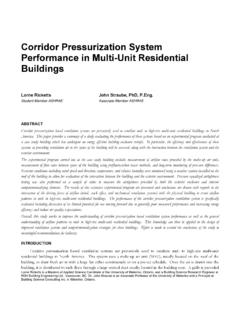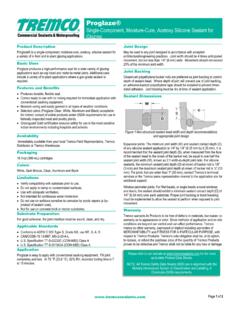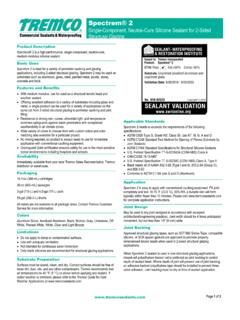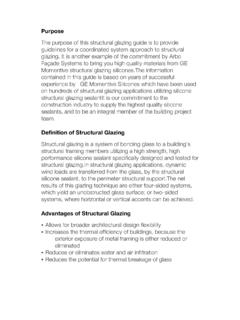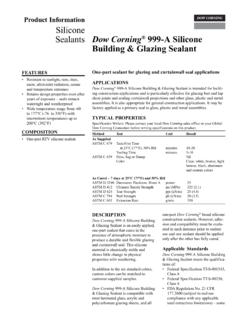Transcription of Re-Glazing of All Glass Curtain Wall Buildings
1 Re-Glazing of All Glass Curtain Wall Buildings James Higgins1, Brian Hubbs, 2, and Graham Finch, MASc, P. Eng 3. ABSTRACT. A desire for more thermally efficient glazing systems has led the development of new proprietary triple and even quadruple glazed insulated glazing units (IGUs) to be used in some Buildings . Unfortunately, the use of some new IGU technologies has led to premature glazing failure and has resulted in the need to re-glaze Buildings at significant costs to the owners of these Buildings . In 2013, one such Re-Glazing project was completed on an all Glass mixed use multi-unit residential building over a luxury hotel, which was fully occupied during the process. The replacement work was facilitated by the planning and use of a unique Re-Glazing program, and the design and construction of a suspended scaffolding ring platform hung from the top of the building . This allowed the new 500 lb glazing units to be replaced from the exterior of the building with minimal disruption to the suite occupants during the work period.
2 The completion of the project in nine months from scaffolding erection to dismantling demonstrates the success of the Re-Glazing replacement plan and suspended scaffolding system, and provides good lessons for future Re-Glazing projects of all Glass towers. Lessons learned will be relevant to glazing designers and specifiers, architects, engineers, glazing contractors and construction managers. 1. James Higgins, RDH building Engineering Ltd, Vancouver, BC, Canada 2. Brian Hubbs, , RDH building Engineering Ltd, Vancouver, BC, Canada 3. Graham Finch, MASc, P. Eng, RDH building Engineering Ltd, Vancouver, BC, Canada 1. 1. INTRODUCTION. Background The high-rise multi-unit residential building was built in 2002 and consists of entirely silicone structurally glazed (SSG) Curtain wall using R-5 proprietary triple glazed IGUs. The high-rise is a mixed-use 48 storey tower, with residential condominiums in the top 17 floors, and a hotel occupying the floors below. The top residential floors of the building incorporate a different Glass low-e coating (silver) than the hotel floors (stainless steel) as a result of a late change in glazing color and properties during the construction of the building .
3 Fogging inside a high percentage of the IGUs was first observed in 2003, though only the clear Glass on the upper floors made the fogging highly visible to the occupants. Several initial attempts were made by the contractor to fix the problem but without success. Within a few years the condensation moisture led to corrosion of the surface #2 silver low-e coating within the IGUs of the condominium floors. Our firm was retained in 2006 by the owners to investigate the IGU. failure. The investigation was completed between 2006 and 2009. Figure 1: Widespread fogging within each IGU Figure 2: Fogging and corrosion of the low-e coating visible on the building elevation from the street. due to condensation within the IGU. Investigation The comprehensive investigation of the IGU failure consisted of both qualitative and quantitative measurement in order to track and document the progression of the failure. The investigation consisted of the following procedures (Finch 2012): Visual review on site to rate IGUs based on fogging and low-e corrosion visible from the interior, Dew/frost-point testing (ASTM E-576) to measure moisture in the IGU airspace and estimate the saturation level of the desiccant, Laboratory desiccant saturation measurement, 2.
4 IGU pressure testing and flow testing to measure leakage rate of IGUs and flow through desiccant tubes, and Submersion testing of removed IGU to visually review leakage points (Figure 3). The investigation determined that the primary failure mechanism causing fogging and low-e corrosion was a poorly designed and constructed proprietary IGU edge spacer. The edge spacer design, shown in Figure 4, used a combination of aluminium, PVC, stainless steel foil, and hot- melt butyl to create a more thermally efficient edge spacer. However, the combination of materials and different coefficients of thermal expansion/contraction led to premature failure of the edge seal at numerous points. In addition, the replaceable desiccant tube design led to increased air and moisture flow into the IGU, which contributed to the failure. Figure 3: Submerged IGU with airflow from Figure 4: Proprietary thermally efficient edge spacer discontinuities in the edge seal. design. Additional glazing issues not directly linked to the fogging and low-e corrosion were also discovered.
5 The clear glazing on the upper residential floors of the building were found to be contributing to significant heat gain within the suites, especially in those with southern exposure. Interior ambient temperatures reached up to 110 F near the windows on sunny days. The clear glazing and change in low-e coating during construction meant that the suite air conditioning system was too small to overcome the solar heat gain. Several IGUs were also found to have nickel sulfide inclusions in the Glass lites causing spontaneous breakage. This failure is linked to poor quality control in the Glass factory, where a small inclusion is embedded in the Glass during the Glass tempering process, and slowly expands causing eventual breakage of the Glass . The findings of the investigation and the ongoing fogging and thermal discomfort prompted the owners to seek a replacement of all the Glass on the residential floors. The IGUs on the hotel floors using a darker tint and stainless steel low-e coating did not experience the same level of corrosion, and the hotel was not prepared to undergo the extensive work required.
6 3. 2. INSULATED glazing UNIT REPLACEMENT. IGU Selection The Glass selection process began as the first step in the glazing replacement project. The initial focus was aesthetically matching the new IGU colouring with the existing hotel floors, so that the building would have a consistent glazing colour for all floors. The original IGU manufacturer no longer offers the low-e coating used on the hotel floors, so a match had to be made by trial and error. Hundreds of samples were collected from several manufacturers in order to narrow down the selection for both the city building authorities and the building owners to choose from. Different low-e coating combinations and Glass tints were used on the interior and exterior surfaces of the Glass lites, in order to replicate the tint of the hotel portion of the building , as visible from the exterior. In addition to matching the colour, the IGUs had to have an improved thermal performance over the existing clear IGUs. The solar heat gain coefficient (SHGC) had to be improved in order to reduce the heat gain and overheating issues due to the undersized air conditioning units.
7 It was determined that the replacement IGUs must be triple glazed using all Glass lites, compared to the original triple glazed using a suspended clear plastic film. Once the IGU selection was narrowed down, several full size triple glazed mock-ups were ordered and installed on the building at the lower hotel floors (see Figure 5). This process was important to be able to view the proposed replacement IGUs directly next to the existing hotel glazing in different lighting conditions. This step proved to be useful in further narrowing the selection, and discovering significantly mismatched colours prior to the full scale manufacturing (see Figure 6). The final colour was selected on-site from the full-scale mock-ups. 2. 1 2 1. Figure 5 : Five full scale mock-ups installed at the Figure 6: Significantly mismatched colour samples lower hotel floors for colour comparison. made visible in indirect sunlight on the building face. In addition to the Glass selection process, work was completed to ensure the most appropriate edge spacer was used.
8 Thermally broken edge spacers using plastic thermal breaks were considered, but ruled out due to the risk of using relatively new and untested technology in IGUs in a project that has already experienced a systemic IGU failure. As well, the triple glazed IGUs help to overcome the potential thermal degradation due to continuous metal thermal spacer. 4. Ultimately an anodized aluminium edge spacer was used with a polyisobutylene primary seal and silicone secondary seal at each air space. Argon fill was used to further increase the thermal performance of the replacement IGUs. Our firm visited the IGU factory on several occasions. The visits were completed to review the quality assurance/quality control procedures for the IGU manufacturing process. Several modifications had to be made to the manufacturing procedure for the custom IGUs. The large size and triple glazing required specialty made tools and assembly apparatuses. IGU Structural Attachment The building uses a unique aluminium frame Curtain wall system, shown in Figure 7, where the IGUs are adhered to the frame using structural silicone on the offset edge of the exterior most lite.
9 The SSG Curtain wall achieves an architecturally appealing look with no extruding mullions or snap caps. The original IGU installation work was completed at the factory and the Curtain wall frame was then installed on the building . This SSG system presented a difficult challenge with respect to glazing replacement work. The Curtain wall frame could not be removed from the building , so the replacement work had to be completed in the field. This work has to meet factory quality control standards and meet the same air leakage and water penetration control performance standards as the factory installed SSG system. In addition, the design of the Curtain wall fame only allowed glazing replacement work from the exterior of the building . This means that the replacement work had to consist of: 1. Removing existing IGUs from the Curtain wall frame and discarding them 2. Installing replacement IGUs in the Curtain wall frame using structural silicone sealant 3. Holding the replacement IGUs securely in place while the structural silicone cures 4.
10 Installing silicone sealant the joints between the IGUs for water shedding and aesthetics The replacement work also had to be completed in a timely matter during seasons with more agreeable weather, and could not require any significant alterations or damage to the interior of the suites. These restrictions can be a challenge in the coastal climate of Vancouver, BC where the rainy season regularly falls from October to April. Traditional SSG replacement work uses short sections of intermittent pressure plates, known as dutchies, to hold the glazing in place at the edges. Structural silicone is then installed around the dutchies. These are then removed once the silicone has cured, and the small sections without silicone are filled in. This work requires the initial structural silicone be left in place to cure for up to 30 days in order to achieve the required structural strength to hold the Glass in place so that the dutchies are no longer needed. This replacement work is often used for single broken or damaged IGUs, but presents a difficult logistical challenge when dealing with a full replacement project on multiple floors.


